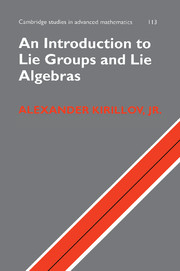Book contents
- Frontmatter
- Contents
- Preface
- 1 Introduction
- 2 Lie groups: basic definitions
- 3 Lie groups and Lie algebras
- 4 Representations of Lie groups and Lie algebras
- 5 Structure theory of Lie algebras
- 6 Complex semisimple Lie algebras
- 7 Root systems
- 8 Representations of semisimple Lie algebras
- Overview of the literature
- Appendix A Root systems and simple Lie algebras
- Appendix B Sample syllabus
- List of notation
- Bibliography
- Index
6 - Complex semisimple Lie algebras
Published online by Cambridge University Press: 31 May 2010
- Frontmatter
- Contents
- Preface
- 1 Introduction
- 2 Lie groups: basic definitions
- 3 Lie groups and Lie algebras
- 4 Representations of Lie groups and Lie algebras
- 5 Structure theory of Lie algebras
- 6 Complex semisimple Lie algebras
- 7 Root systems
- 8 Representations of semisimple Lie algebras
- Overview of the literature
- Appendix A Root systems and simple Lie algebras
- Appendix B Sample syllabus
- List of notation
- Bibliography
- Index
Summary
In this chapter, we begin the study of semisimple Lie algebras and their representations. This is one of the highest achievements of the theory of Lie algebras, which has numerous applications (for example, to physics), not to mention that it is also one of the most beautiful areas of mathematics.
Throughout this chapter, g is a finite-dimensional semisimple Lie algebra (see Definition 5.35); unless specified otherwise, g is complex.
Properties of semisimple Lie algebras
Cartan's criterion of semimplicity, proved in Section 5.8, is not very convenient for practical computations. However, it is extremely useful for theoretical considerations.
Proposition 6.1.Let g be a real Lie algebra and gℂ – its complexification (see Definition 3.49). Then g is semisimple iff gℂis semisimple.
Proof. Immediately follows from Cartan's criterion of semisimplicity.
Remark 6.2. This theorem fails if we replace the word “semisimple” by “simple”: there exist simple real Lie algebras g such that gℂ is a direct sum of two simple algebras.
Theorem 6.3.Let g be a semisimple Lie algebra, and I ⊂ g – an ideal. Then there is an ideal I' such that g = I ⊕ I'.
Proof. Let I⊥ be the orthogonal complement with respect to the Killing form. By Lemma 5.45, I⊥ is an ideal. Consider the intersection I ∩ I⊥. It is an ideal in g with zero Killing form (by Exercise 5.1). Thus, by Cartan criterion, it is solvable.
- Type
- Chapter
- Information
- An Introduction to Lie Groups and Lie Algebras , pp. 108 - 131Publisher: Cambridge University PressPrint publication year: 2008

